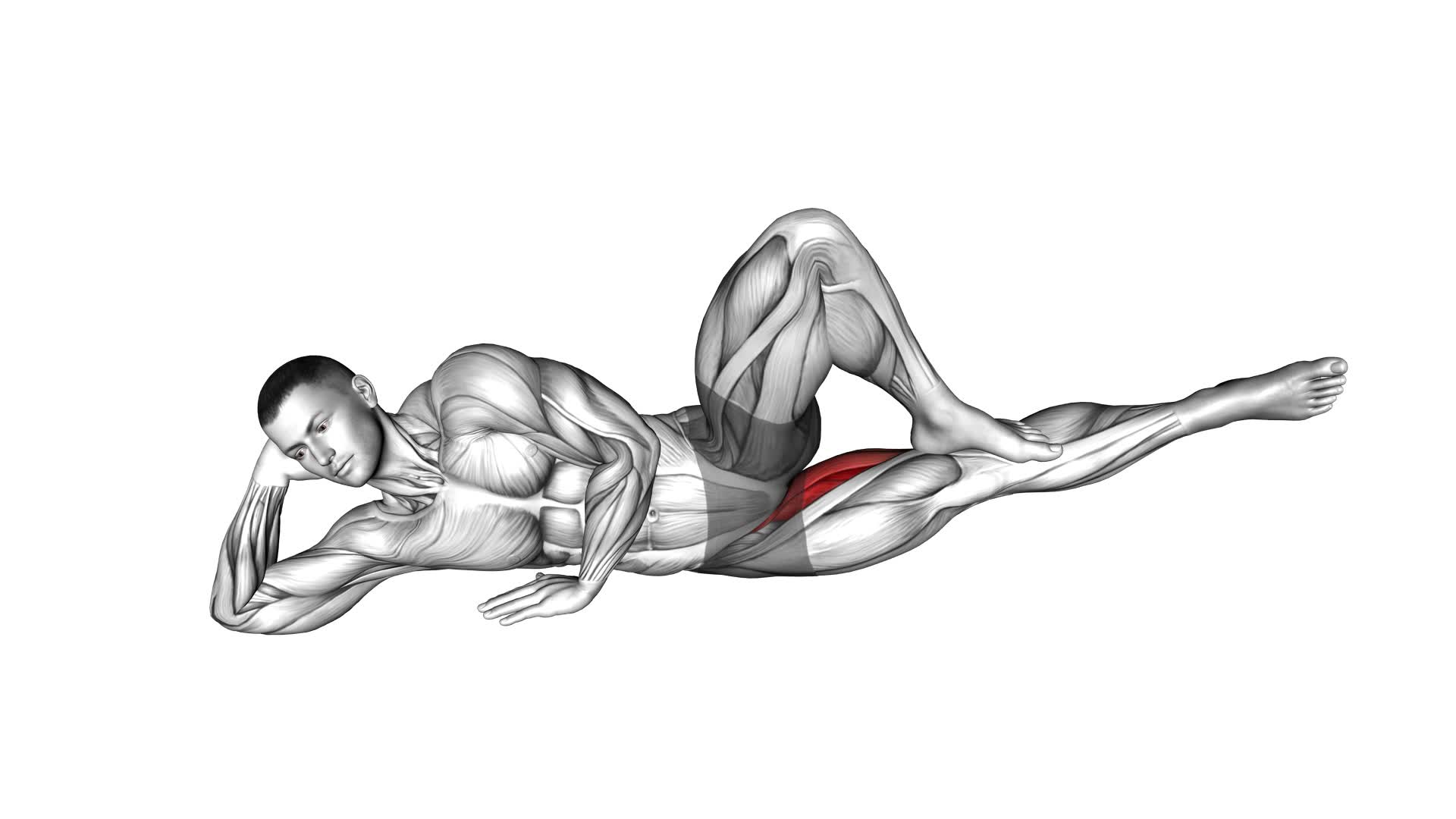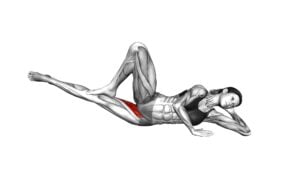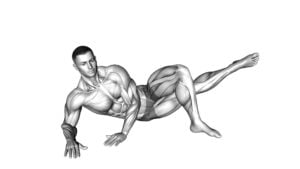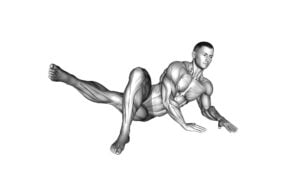Bodyweight Side Lying Leg Adduction (male) – Video Exercise Guide & Tips

Are you looking for an effective exercise to target your inner thighs? Look no further than the bodyweight side lying leg adduction! This exercise specifically targets the adductor muscles and can be done by males of all fitness levels.
Watch This Exercise Video
In this video exercise guide, you will learn the proper form and technique, common mistakes to avoid, and tips for increasing intensity.
Get ready to strengthen and tone your inner thighs with this challenging yet rewarding exercise.
Key Takeaways
- Bodyweight side lying leg adduction targets the inner thigh muscles and helps strengthen and tone them.
- This exercise improves stability and balance in the lower body, which can help prevent injuries to the hips, knees, and ankles.
- Adding this exercise to your routine can enhance overall athletic performance.
- To increase the intensity and progressive overload, you can incorporate variations, use ankle weights or resistance bands, and gradually increase repetitions or resistance over time.
Benefits of Bodyweight Side Lying Leg Adduction
You will experience several benefits from incorporating bodyweight side lying leg adduction into your workout routine. This exercise specifically targets your inner thigh muscles, known as the adductors. By performing this exercise regularly, you can strengthen and tone these muscles, leading to improved stability and balance in your lower body.
One of the key benefits of bodyweight side lying leg adduction is that it can help prevent injuries. Strong adductors provide support to your hips, knees, and ankles, reducing the risk of strains or sprains during activities like running or jumping. Additionally, this exercise can enhance your overall athletic performance by increasing your power and agility.
Proper form and technique are crucial when performing bodyweight side lying leg adduction. To begin, lie on your side with your legs stacked on top of each other. Keep your bottom leg straight and lift your top leg towards the ceiling, focusing on engaging your inner thigh muscles. It's important to maintain control throughout the movement and avoid using momentum. Slowly lower your leg back down and repeat for the desired number of repetitions.
Incorporating bodyweight side lying leg adduction into your workout routine is an effective way to target and strengthen your inner thigh muscles. The benefits of this exercise include injury prevention, improved athletic performance, and increased stability. Remember to always use proper form and technique to maximize the effectiveness of this exercise.
Proper Form and Technique for Males
To perform the bodyweight side lying leg adduction exercise correctly as a male, follow these guidelines for proper form and technique.
First, ensure proper body alignment by lying on your side with your legs extended straight and stacked on top of each other. Keep your hips and shoulders in line with each other, and maintain a neutral spine throughout the exercise.
Next, engage the muscles of your inner thigh by activating your adductors. Start by exhaling as you lift your top leg upward, keeping your foot in a flexed position. Be careful not to let your hip roll forward or backward during the movement.
As you reach the top position, pause briefly and then inhale as you lower your leg back down to the starting position. Remember to maintain control throughout the exercise and avoid any jerky or sudden movements.
Equipment Needed for the Exercise
To perform the bodyweight side lying leg adduction exercise correctly as a male, you won't need any equipment. This exercise can be done using only your bodyweight, making it convenient and accessible for everyone. One of the great things about bodyweight exercises is that they can be done anywhere, anytime, without the need for specialized equipment or a gym membership.
However, if you want to add some variety or increase the intensity of the exercise, there are a few variations and modifications you can try. For example, you can use ankle weights to add resistance and challenge your muscles even more. Another option is to use a resistance band around your thighs to provide additional resistance as you perform the leg adduction movement.
Additionally, you can modify the exercise by adjusting the position of your body. Instead of lying on your side, you can try the exercise while lying on your back or in a seated position. These variations can target different muscles and add some variety to your workout routine.
Common Mistakes to Avoid
When performing the side lying leg adduction exercise, it's important to maintain proper form to maximize its benefits.
One common mistake to avoid is excessive hip movement, as it can take away from the targeted muscles and reduce the effectiveness of the exercise.
To engage the inner thighs effectively, focus on squeezing them throughout the movement and avoid relying solely on momentum.
Proper Form Importance
Maintaining proper form during the Bodyweight Side Lying Leg Adduction exercise is crucial for maximizing results and preventing potential injuries. Here are three reasons why proper form is important for this exercise:
- Effective muscle activation: Proper technique ensures that the targeted muscles, such as the adductors, are engaged and activated optimally. This allows for better muscle development and overall strength gains.
- Injury prevention: By maintaining proper form, you reduce the risk of straining or overloading the muscles and joints involved in the exercise. This helps to prevent injuries, such as strains or sprains, that could hinder your progress or sideline your training altogether.
- Efficient movement patterns: Proper form promotes efficient movement patterns, meaning you're using the correct muscles in the correct sequence. This improves coordination, stability, and overall movement quality, leading to better overall performance and reduced risk of imbalances or compensations.
Avoiding Excessive Hip Movement
How can you prevent excessive hip movement during the Bodyweight Side Lying Leg Adduction exercise?
Avoiding excessive hip rotation is key to performing this exercise correctly and maximizing muscle activation in the glutes.
To avoid excessive hip movement, ensure that your hips remain stacked and aligned throughout the movement. Keep your top hip stable and avoid any rocking or rolling motion.
Additionally, focus on engaging your glute muscles and keeping them activated throughout the exercise. This will help to stabilize your hips and prevent them from moving excessively.
Engaging the Inner Thighs
To engage your inner thighs effectively during the Bodyweight Side Lying Leg Adduction exercise, focus on squeezing your legs together throughout the movement. Engaging the inner thighs is crucial for strengthening the hip abductors and improving overall lower body stability.
Here are three common mistakes to avoid when trying to engage your inner thighs:
- Allowing the top leg to relax: Keep both legs active throughout the exercise. Don't let the top leg flop or rest on the bottom leg.
- Using momentum instead of muscle control: Avoid swinging the leg up or down. Instead, use slow and controlled movements to target the inner thighs effectively.
- Neglecting proper alignment: Keep your body in a straight line during the exercise. Avoid letting your hips roll forward or backward, as this can diminish the engagement of the inner thighs.
Tips for Increasing Intensity
To increase the intensity of the bodyweight side lying leg adduction exercise, you can incorporate progressive overload techniques. This means gradually increasing the resistance or difficulty of the exercise over time.
One effective way to do this is by using resistance bands, which provide added resistance to challenge your muscles further.
Progressive Overload Techniques
To increase the intensity of your bodyweight side lying leg adduction exercise, incorporate progressive overload techniques such as adding resistance or increasing repetitions. Progressive overload techniques are essential for continually challenging your muscles and making progress in your fitness journey.
Here are three effective ways to implement progressive overload:
- Increase Resistance:
Use ankle weights or resistance bands to add extra resistance to the exercise. This will make your muscles work harder and encourage muscle growth.
- Increase Repetitions:
Gradually increase the number of repetitions you perform for each set. This will push your muscles to fatigue and stimulate further strength gains.
- Decrease Rest Time:
Shorten the rest periods between sets to keep your muscles engaged and maintain a higher level of intensity throughout your workout.
By incorporating these progressive overload techniques, you can effectively increase the intensity of your bodyweight side lying leg adduction exercise and continue to challenge your muscles for optimal results.
Now, let's explore how incorporating resistance bands can further enhance your workout.
Incorporating Resistance Bands
To further enhance the intensity of your bodyweight side lying leg adduction exercise, incorporate resistance bands for added resistance and muscle engagement. Resistance bands are a great tool to increase the challenge of your workouts and target specific muscles more effectively.
With resistance bands, you can easily adjust the level of resistance by using bands with different strengths. To incorporate resistance bands into your side lying leg adduction exercise, simply loop the band around your ankles and perform the exercise as usual.
The resistance provided by the bands will make your muscles work harder, leading to increased strength and muscle development. If you don't have access to resistance bands, there are alternative exercises you can try, such as cable adductions or machine adductions, which also provide resistance to the adductor muscles.
Variations and Modifications for Different Fitness Levels
Adjust the intensity of the bodyweight side lying leg adduction to better suit your fitness level. Here are some variations and modifications you can try:
- Beginner Level: If you're new to this exercise or have limited mobility, you can start by performing the side lying leg adduction with your knees slightly bent. This will reduce the range of motion and make it easier to control the movement.
- Intermediate Level: Once you've mastered the basic form, you can increase the challenge by straightening your legs and adding ankle weights. This will engage your muscles more intensely and help you build strength and endurance.
- Advanced Level: For those looking for an extra challenge, you can try performing the side lying leg adduction on an inclined bench. This will increase the resistance and target your muscles from a different angle, providing a greater challenge for your core and hip muscles.
Remember to listen to your body and progress at your own pace. It's important to maintain proper form and avoid any pain or discomfort during the exercise. As you get stronger, you can gradually increase the intensity and difficulty of the side lying leg adduction to continue challenging your muscles and achieving your fitness goals.
Frequently Asked Questions
How Many Calories Does Bodyweight Side Lying Leg Adduction Burn?
Bodyweight side lying leg adduction is a knee-friendly exercise that helps strengthen your inner thighs.
While it's an effective workout, the number of calories burned can vary depending on factors like your weight and intensity level. Generally, bodyweight exercises burn fewer calories compared to high-intensity workouts.
However, incorporating this exercise into your routine can still contribute to overall calorie burn. Remember to focus on proper form and gradually increase intensity for the best results.
Can Bodyweight Side Lying Leg Adduction Help Reduce Love Handles?
Bodyweight exercises for love handles can be effective in reducing excess fat around the waist.
One such exercise is bodyweight side lying leg adduction. It targets the inner thighs and hip muscles, helping to strengthen and tone those areas.
By incorporating this exercise into your fitness routine, you can work towards reducing love handles and achieving a more sculpted waistline.
The benefits of bodyweight leg adduction include improved muscle definition, increased stability, and enhanced overall strength.
Is This Exercise Suitable for Individuals With Knee Pain?
If you have knee pain, it's important to find exercises that won't aggravate it. There are alternative exercises you can try that are suitable for individuals with knee pain.
It's also important to manage and prevent knee pain during workouts. Here are some tips to help you: warm up properly, use proper form, avoid high-impact activities, and listen to your body.
How Often Should One Perform Bodyweight Side Lying Leg Adduction to See Results?
To see results from bodyweight side lying leg adduction, it's important to perform the exercise with proper form and frequency.
The proper form involves lying on your side and lifting your top leg towards the ceiling, keeping your core engaged.
Aim to do this exercise at least 2-3 times per week, allowing for a day of rest in between sessions.
Consistency and proper technique will help you achieve the desired results.
Can Bodyweight Side Lying Leg Adduction Help Improve Hip Flexibility?
Bodyweight side lying leg adduction can definitely improve your hip flexibility. This exercise specifically targets the muscles responsible for hip adduction, which helps increase the range of motion in your hips.
Athletes can benefit from this exercise as it enhances their overall flexibility and can improve their performance in sports that require hip mobility.
If you're a beginner, you can modify this exercise by using a resistance band or performing it with your knees slightly bent to make it easier and gradually build up your strength and flexibility.
Conclusion
In conclusion, the bodyweight side lying leg adduction is a beneficial exercise for males looking to strengthen their inner thigh muscles. By using proper form and avoiding common mistakes, individuals can effectively target this specific muscle group.
Adding variations and modifications can help increase the intensity of the exercise, making it suitable for different fitness levels. Incorporating this exercise into a regular workout routine can improve overall lower body strength and stability.

Author
Years ago, the spark of my life’s passion ignited in my mind the moment I stepped into the local gym for the first time. The inaugural bead of perspiration, the initial endeavor, the very first surge of endorphins, and a sense of pride that washed over me post-workout marked the beginning of my deep-seated interest in strength sports, fitness, and sports nutrition. This very curiosity blossomed rapidly into a profound fascination, propelling me to earn a Master’s degree in Physical Education from the Academy of Physical Education in Krakow, followed by a Sports Manager diploma from the Jagiellonian University. My journey of growth led me to gain more specialized qualifications, such as being a certified personal trainer with a focus on sports dietetics, a lifeguard, and an instructor for wellness and corrective gymnastics. Theoretical knowledge paired seamlessly with practical experience, reinforcing my belief that the transformation of individuals under my guidance was also a reflection of my personal growth. This belief holds true even today. Each day, I strive to push the boundaries and explore new realms. These realms gently elevate me to greater heights. The unique combination of passion for my field and the continuous quest for growth fuels my drive to break new ground.







